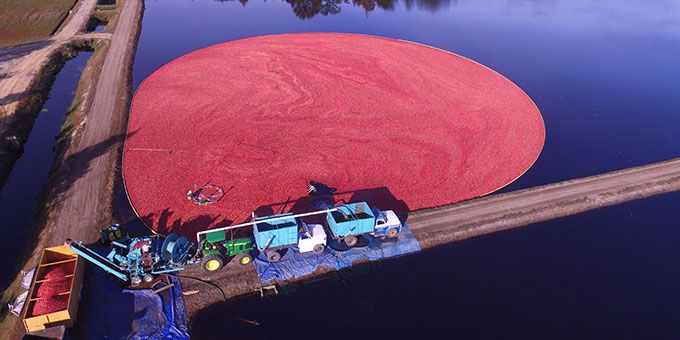Previously, Lee relied on hand-held digital and mercury thermometers to monitor the bogs’ nighttime temperatures, but he wanted a more autonomous and hierarchical system that allowed for continuous monitoring of multiple variables.
 Cranberry Farm Goes High-Tech
Cranberry Farm Goes High-Tech

Case Study from | WIN-911
The 200-year-old cranberry industry is now a multi-billion dollar business. While grown in just five states, the U.S. is the world’s leading cranberry producer harvesting approximately 40,800 acres of cranberries, which yielded nearly 8.7 million barrels in 2017.
Over the years, farmers have improved yield-per-acre by planting higher-producing varieties and improving farming practices. For example, sorting fruit through wooden slats has given way to computerized scanners that scrutinize the berries for color, firmness, and imperfections. To meet high consumer demand, increase efficiency, and ensure family farms prosper for future generations, many growers are investing in other high-tech equipment to more quickly harvest, sort and package the fruit.
Technology Yields New Growth
The agriculture industry has radically transformed over the past 50 years. Advances in machinery have expanded the scale, speed, and productivity of farm equipment, leading to more efficient cultivation of more land. Artificial intelligence, analytics, connected sensors, and other emerging technologies could further increase yields, improve the efficiency of water and other inputs, and build sustainability and resilience across crop cultivation. Advances in technology also help monitor critical environmental conditions and state-of-the-art machines.
Lee Brothers, Inc.
Chatsworth, New Jersey
Lee Brothers, Inc., was founded in 1860 when Stephen Lee, a young engineer and Irish immigrant, purchased roughly 2,000 acres in the New Jersey pinelands. Learning that cranberries grow best along a stream, Lee realized that if he built a dam to hold the water back, in the winter he could flood the cranberries and yield higher production. This ingenuity has reaped much success for the generations carrying on the family-farming legacy on the 135 contiguous acres of cranberry bogs and 1,700 acres of surrounding woodlands. For this family, cranberry farming is not just a job but a way of life.
Lee Brothers, Inc., is now run by Stephen Lee III (Lee) and his son, Stephen Lee IV who manages the farm’s day-to-day operations. Both men know that it takes more than ingenuity to be successful in today’s complex, competitive agriculture and food processing industry. Ensuring ideal bog conditions is critical to maximizing harvests. With a small team to run the operation, missing changing weather conditions could jeopardize the entire crop. Since monitoring a cranberry bog is a 24/7 operation, Lee and his son stayed up all night in shifts, especially when frost or other inclement weather threatened to harm the crops. This was not a viable, long-term strategy for success. The family wanted to integrate and leverage technology to complement the team and change the 24/7 schedule.
Advanced Technology
Since 1952, Lee Brothers, Inc., has been an Ocean Spray® farmer-owner, a cooperative that began in 1930 by three cranberry farmers and now includes over 700 grower families across North and South America. This cooperative provides a sharing of ownership, ideas, and innovation, which is how Lee first learned about SCADA and WIN-911, a remote alarm monitoring software.
Previously, Lee relied on hand-held digital and mercury thermometers to monitor the bogs’ nighttime temperatures, but he wanted a more autonomous and hierarchical system that allowed for continuous monitoring of multiple variables. After talking with an Ocean Spray operations vice president and conducting research, in 2011, Lee installed the GE CIMPLICTY SCADA system integrated with remote alarm notification software, which have proven crucial to the crops’ annual success.
“Having remote alarm notification software is critical for us to be able to manage the operation with a minimum number of people during the off hours,” Lee commented.
Leaving Nothing To Chance
Lee Brothers has been using the software for over ten years and started with modems and alphanumeric pagers. Today, Lee Brothers relies on the software company’s mobile app to alert them of any conditions that may impact the crops.
As every farmer knows, crop production is dependent on the weather. Fortunately, however, modern technology allows for intervention to minimize risk and increase yield. The Lee Brothers’ bogs rely on six pump houses to continuously monitor soil moisture and temperature conditions. If a bog is exposed to temperatures that are too high or too low, the year’s flowers or berries could be destroyed and the vines which, if healthy, can produce fruit for up to 60 years, could be damaged. The installed technology allows each pump house to be autonomous and continuously report bog conditions back to the SCADA. If the temperatures fall below or above optimum levels, the remote alarm notification software notifies Lee and his team via the mobile app. The pump house then begins to run for a preset length of time and will continue monitoring the temperature again until conditions return to a range that is safe for the cranberry vines.
Lee recounted the importance of having the alarm notification software and explained that since frost typically occurs between 10:00 p.m. and 6:00 a.m., the alarm notification prevents the Lees from not knowing about this risk during the night. Because both Lee and his son live just one mile from the farm, they can quickly respond to the alarms, assess the sprinklers and make sure everything is operating correctly. It only takes a little leaf of a cranberry vine to get in the sprinkler nozzle, plug it up and potentially threaten crop damage.
“Approximately six to eight times during the growing season a pump will malfunction. Without the notification software alerting us to this problem our crops are threatened. Each time we get an alarm prevents crop loss,” Lee said.
Sensors also monitor other weather conditions such as soil moisture, wind trends, solar radiation, and rainfall. Just as it’s important to protect the cranberries during a frost, monitoring solar radiation is critical to preventing the berries from being scalded or even cooked from the hot, summer sun. The sensors connected to the SCADA system trigger an alarm whenever the pumps work to slightly cool the cranberries.
Lee implemented the current hierarchical SCADA system and notification software because it allows for future expansion. At the end of each growing season, this software with SCADA permits Lee and his team to pull from archived historical data and assist in planning for additional sensors to monitor environmental conditions in the cranberry bogs.
- https://www.nationalgeographic.com/history/article/united-states-cranberry-harvest-explained-charts (accessed May 12, 2021).
- Lutz Goedde, Joshua Katz, Alexandre Menard,Julien Revellat, “Agriculture’s connected future: How technology can yield new growth,” McKinsey & Company, October 9, 2020.
The content & opinions in this article are the author’s and do not necessarily represent the views of AgriTechTomorrow
Comments (0)
This post does not have any comments. Be the first to leave a comment below.
Featured Product

